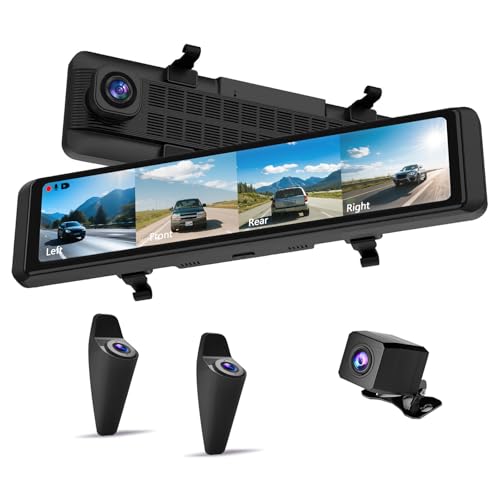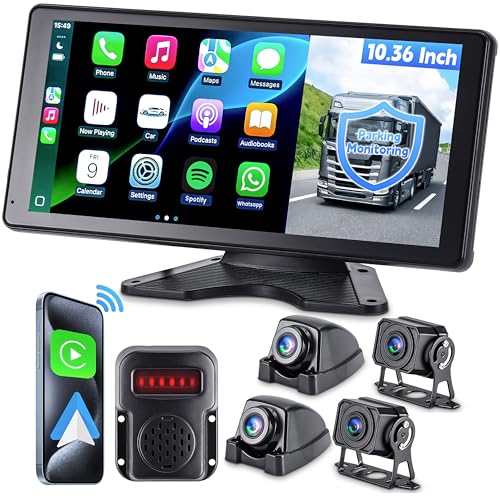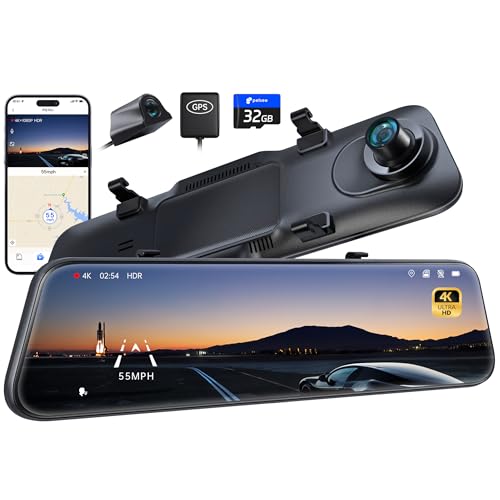As you navigate today’s busy roads, staying aware of your surroundings is essential. Blind spot detection systems have evolved greatly, offering advanced features that enhance your safety. From real-time alerts to seamless integration in various vehicles, these systems are designed for both drivers and motorcyclists. Curious about which options stand out in 2025? Let’s explore the top ten systems that promise to keep you safe on every journey.
Universal Blind Spot Monitoring Assistant System
If you’re looking to enhance your driving safety, the Universal Blind Spot Monitoring Assistant System is an excellent choice. This system uses advanced 24GHz millimeter wave sensors to detect vehicles in your blind spots, especially from the side or rear. With a detection range of 1-32.8ft, it performs well in poor visibility conditions like darkness, rain, or snow. You’ll appreciate the alert mechanism, which activates LED lights and sounds a buzzer when necessary. For peak performance, professional installation is recommended, so be sure to follow the manual for correct sensor positioning and wiring. Stay safe on the road with this reliable system!
Best For: Drivers seeking to improve safety by monitoring blind spots, especially in adverse weather conditions.
Pros:
- Enhanced Safety: Effectively detects vehicles in blind spots, reducing the risk of accidents during lane changes.
- Versatile Detection Range: Operates well in various conditions, including darkness, rain, and snow, with a range of up to 32.8ft.
- Clear Alerts: Provides visual and audible warnings to ensure drivers are aware of potential hazards.
Cons:
- Professional Installation Required: Installation can be complicated, necessitating professional help for optimal sensor positioning and wiring.
- Metal Interference: Sensors cannot penetrate metal, which may limit placement options in some vehicle designs.
- Additional Cost: The need for professional installation could increase the overall expense for the system.
MUYACDSTG 12 Rear View Mirror Camera with BSD Blind Spot Monitoring
The MUYACDSTG 12 Rear View Mirror Camera with BSD Blind Spot Monitoring is an ideal choice for safety-conscious drivers who want enhanced visibility on the road. This device features a 4-channel recording system with a 2K front lens and three 1080P cameras, providing a 170° wide-angle view to minimize blind spots. Its real-time BSD system alerts you to nearby vehicles or pedestrians, boosting safety. With a 12-inch IPS touchscreen, you can easily navigate through split-screen settings. Plus, the reverse assist functionality helps during parking. Dual power options make installation a breeze, and 24/7 technical support is always available.
Best For: Safety-conscious drivers seeking enhanced visibility and monitoring while on the road.
Pros:
- 4-channel recording system with high-resolution cameras for comprehensive coverage.
- Real-time BSD alerts enhance safety by notifying drivers of nearby vehicles and pedestrians.
- Easy installation with dual power options and a user-friendly touchscreen interface.
Cons:
- Requires a 12V power supply, making it incompatible with 24V systems.
- The size of the 12-inch display may obstruct visibility for some drivers.
- Initial setup may require technical knowledge for optimal installation and configuration.
EASYGUARD EBS001 Car Blind Spot Monitor System
For drivers seeking enhanced safety during lane changes, the EASYGUARD EBS001 Car Blind Spot Monitor System stands out with its advanced 24GHz microwave sensors. This system detects objects in adjacent lanes up to 12 meters away, alerting you with LED indicators when a vehicle enters your blind spot. When you engage the lane change assistant, the LED flashes rapidly, and a buzzer emits three beeps for immediate awareness. Installation may require some mechanical skills, but many users appreciate its performance and reliability, despite occasional false alarms. With support available, the EASYGUARD EBS001 is a solid choice for safer driving.
Best For: Drivers looking for an effective and reliable blind spot detection system to enhance safety during lane changes.
Pros:
- Easy detection of vehicles in blind spots with a range of up to 12 meters.
- Provides timely alerts through LED indicators and audible warnings during lane changes.
- Compatible with most DC12v vehicles, making it versatile for a variety of cars.
Cons:
- Some users experience false alarms, detecting non-existent objects.
- Installation may be challenging for novices and requires mechanical skills.
- Occasional issues reported with wire lengths and sensor placements during installation.
INNOVV ThirdEYE Motorcycle Blind Spot System
Riders seeking enhanced safety and awareness on the road will find the INNOVV ThirdEYE Motorcycle Blind Spot System an exceptional choice in blind spot detection. This system alerts you to hazards with audio and LED indicators, boasting a 150° detection angle. Its high-precision 77-79 GHz sensors accurately calculate speed differences, detecting up to 64 targets within 50 meters. Installation is straightforward, compatible with various motorcycles, and takes about 90 minutes. Users report effective performance, especially on highways, and the system’s IP67 rating guarantees durability. Priced around $268, it’s a worthy investment for those prioritizing safety on the road.
Best For: Riders who frequently travel on highways and prioritize safety and awareness in detecting blind spots.
Pros:
- High-precision sensors detect up to 64 targets simultaneously, enhancing rider awareness.
- Easy installation compatible with various motorcycle types, averaging around 90 minutes.
- Durable IP67 waterproof and dustproof design ensures functionality in diverse weather conditions.
Cons:
- Some users have reported a need for sturdier wiring and additional components for installation.
- Limited effectiveness noted by some riders on two-lane roads, suggesting variable performance.
- Additional features like phone connectivity could enhance overall product value.
RV Camera System with 10.36 Monitor and 4 1080P Backup Cameras
Equipped with a stunning 10.36-inch HD touchscreen monitor, the RV Camera System with four 1080P backup cameras is perfect for those who prioritize safety and convenience on the road. This system features 360° blind spot monitoring, providing real-time coverage and customizable zones with alerts. The four cameras come with night vision and are housed in durable, waterproof casings. With Bluetooth and Wi-Fi connectivity, you can enjoy seamless access to navigation and music through CarPlay and Android Auto. Plus, voice control and easy plug-and-play installation make it user-friendly, ensuring you stay safe wherever your adventures take you.
Best For: RV owners and travelers who prioritize safety and convenience with advanced monitoring technology.
Pros:
- High-definition 10.36-inch touchscreen monitor offers clear visuals for monitoring your surroundings.
- Night vision capabilities ensure visibility in low-light conditions, enhancing safety during evening travels.
- Seamless integration with CarPlay and Android Auto allows for easy access to navigation and entertainment on the road.
Cons:
- Some users report issues with camera resolution, which may affect image clarity.
- App functionality complaints indicate potential connectivity or usability challenges for some users.
- Installation may require basic wiring knowledge, which could be a barrier for those unfamiliar with vehicle setups.
Motorcycle BSD Blind Spot Detection System with Indicators Alert
The WEUASTE BSD01 Motorcycle Blind Spot Detection System is an essential safety upgrade for motorcyclists who value awareness on the road. With its 360° protection, it monitors vehicles from behind, left, and right using a 24GHz millimeter wave sensor. You’ll receive timely alerts for lane changes within a 30-meter radius, enhancing your safety considerably. Installation is a breeze—no professional help needed. Just attach the warning lights to your mirrors and connect three wires. Plus, it’s waterproof, so you can ride confidently in any weather. Enjoy peace of mind knowing you’re well-protected with this reliable system.
Best For: Motorcyclists seeking enhanced safety and awareness on the road through effective blind spot monitoring.
Pros:
- User-friendly installation requiring no professional assistance.
- Waterproof design ensures reliable performance in various weather conditions.
- Bright warning lights and clear alerts improve rider awareness and safety.
Cons:
- Proper sensor placement and calibration are crucial to avoid false alarms.
- May require adjustments if not installed correctly for optimal performance.
- Initial setup may take time for those unfamiliar with wiring.
AlienRider M7 Motorcycle Blind Spot Detection System
For those seeking enhanced safety on two wheels, the AlienRider M7 Motorcycle Blind Spot Detection System stands out with its advanced 77G millimeter-wave radar technology. This system monitors your blind spots on both sides with a detection range of up to 55 meters, offering real-time alerts. The Lane Change Assistance feature warns you of rapidly approaching vehicles, while the Rear Collision Warning helps prevent accidents from behind with a red light alert. Its compact design allows for discreet installation, and it works effectively in tough weather conditions, ensuring you stay safe and aware on any ride.
Best For: Motorcycle riders seeking advanced safety features and enhanced awareness on the road.
Pros:
- Provides real-time alerts for blind spots and rear collisions, significantly improving rider safety.
- Compact design allows for discreet installation without compromising the motorcycle’s appearance.
- Operates effectively in adverse weather conditions, maintaining performance in heavy rain, fog, and smog.
Cons:
- Installation may require professional assistance for optimal integration.
- The system relies on radar technology, which may not detect all types of vehicles in every situation.
- The compact size may limit some features or adjustments compared to larger systems.
Pelsee P12 Pro 4K Mirror Dash Cam
If you’re looking for a dash cam that not only captures stunning 4K video but also enhances your driving safety, the Pelsee P12 Pro 4K Mirror Dash Cam stands out with its Intelligent Blind Spot Detection (BSD). This device features a 4K Ultra HD front camera and a 1080P rear camera, ensuring clear recordings of road signs and license plates. With ADAS Collision Avoidance Technology, you’ll receive alerts for potential hazards. Plus, its advanced voice control lets you operate the camera hands-free. The 24-hour parking monitor and external GPS provide added security, making it a smart choice for safety-conscious drivers.
Best For: Safety-conscious drivers who want high-quality video recording and advanced collision avoidance features.
Pros:
- High-resolution 4K front camera and 1080P rear camera for clear video capture.
- Advanced voice control allows for hands-free operation, enhancing driver safety.
- 24-hour parking monitor and external GPS provide added security and evidence in case of accidents.
Cons:
- May require additional storage if loop recording frequently overwrites important footage.
- Some users may find the voice control commands limited or challenging to remember.
- Installation may be complex for those unfamiliar with dash cam setups.
Car Blind Spot Camera and Display System
A standout feature of the Car Blind Spot Camera and Display System is its high-definition IPS display, which provides a full view of your vehicle’s blind spots by showcasing left and right images simultaneously. With a 120° side view angle camera and 1080P image quality, you’ll enjoy clear visuals. The adjustable brightness and flexible installation options guarantee ideal viewing at any time. Plus, the system supports sound and light warnings to keep you safe on the road. Weighing just 7.4 ounces, it’s easy to install without compromising your vehicle’s aesthetics, making it a top choice for enhanced driving safety.
Best For: Drivers seeking enhanced safety and visibility while changing lanes or merging, particularly those who frequently navigate busy roads.
Pros:
- High-definition IPS display provides clear visuals of blind spots with simultaneous left and right images.
- Adjustable brightness ensures optimal viewing in various lighting conditions.
- Easy installation process with non-drilled, aesthetic design appeals to a wide range of vehicle models.
Cons:
- Some users may prefer wireless options over the wired connections provided.
- Installation may require basic technical knowledge, which could be challenging for some users.
- Limited warranty information may raise concerns for potential buyers regarding long-term reliability.
Brandmotion Radar Blind Spot System with Cross Traffic Detection (RDBS-1600)
The Brandmotion Radar Blind Spot System with Cross Traffic Detection (RDBS-1600) stands out as an ideal choice for drivers of vehicles manufactured from 2007 onward, thanks to its seamless integration and advanced safety features. With a 40ft radar range, it warns you of nearby vehicles or objects while driving, turning, or reversing. You’ll appreciate the audible alerts and indicator lights, even in sunlight. The system’s cross traffic detection enhances safety when backing up, notifying you of approaching cars. Plus, Brandmotion’s trusted reputation and US-based support, along with a 2-year warranty, guarantee you’re making a reliable investment in your vehicle’s safety.
Best For: Drivers of vehicles manufactured from 2007 onward seeking to enhance their safety while on the road.
Pros:
- Provides audible and visual alerts for nearby vehicles, improving situational awareness.
- Effective cross traffic detection while reversing, reducing the risk of accidents.
- Trusted brand with a 2-year warranty and US-based support for peace of mind.
Cons:
- May require professional installation, which could add to overall costs.
- Limited to vehicles from 2007 and newer, excluding older models.
- Potential for false alerts in certain driving conditions, depending on radar sensitivity.
Factors to Consider When Choosing Blind Spot Detection Systems
When you’re choosing a blind spot detection system, consider key factors like detection range and accuracy to guarantee reliable performance. You’ll also want to think about installation complexity and compatibility with your vehicle type. Finally, evaluate alert mechanisms and how well the system adapts to different environments for ideal safety.
Detection Range and Accuracy
Choosing a blind spot detection system involves considering key factors like detection range and accuracy. The detection range can vary markedly; some systems effectively monitor up to 32.8 feet (10 meters), while others reach up to 55 meters. Accuracy is equally important, especially when systems utilize millimeter-wave radar technology, which can distinguish between moving and stationary objects, reducing false alerts. Look for systems with a horizontal detection angle of up to 150°, as this broadens the monitored area for potential hazards. Also, consider how environmental conditions like rain, fog, or nighttime visibility affect performance. Advanced systems that detect multiple targets simultaneously can further enhance safety by alerting you to nearby vehicles or pedestrians during critical maneuvers.
Installation Complexity and Requirements
Considering detection range and accuracy helps you appreciate the intricacies of blind spot detection systems, but installation complexity and requirements can influence your decision just as much. Some systems need professional installation due to precise sensor positioning and wiring connections. If your vehicle has metal components that might interfere with microwave sensors, installation could become trickier. However, user-friendly options often allow for simple, adhesive-based installations without drilling. Remember, you’ll need to connect power wires to your vehicle’s electrical system, which may require accessing wiring harnesses or taillight connections. Proper calibration and sensor positioning are essential to avoid false alerts, so always follow the installation manual closely to guarantee peak performance and safety on the road.
Alert Mechanisms and Notifications
Effective alert mechanisms and notifications play an essential role in the functionality of blind spot detection systems, ensuring you stay aware of your surroundings. Most systems use visual alerts like LED lights to signal vehicles in your blind spots, activating when your turn signal is on or off. Many also incorporate auditory alerts, such as buzzers or tones that increase in intensity based on how close the detected vehicle is. Advanced systems offer multiple alert modes, including flashing lights and sounds triggered by your turn signal, enhancing your awareness during lane changes. Some systems even provide dual alerts to indicate which side the vehicle is approaching from, boosting your overall situational awareness while driving.
Environmental Adaptability and Durability
When it comes to blind spot detection systems, environmental adaptability and durability are key factors that can greatly impact your driving experience. Look for systems with IP67 or IP68 ratings, ensuring they’re waterproof and dustproof, even in heavy rain or snow. Advanced models using millimeter-wave radar technology at 24GHz or 77GHz can reliably detect obstacles in poor visibility conditions, like fog or smog. Check the operational temperature range, ideally from -40℃ to 80℃, for consistent performance in extreme weather. Durability features, such as shock resistance and corrosion resistance, are also essential for maintaining system integrity over time. By prioritizing these attributes, you’ll enhance your safety on the road, no matter the conditions.
Compatibility With Vehicle Types
Choosing the right blind spot detection system involves ensuring compatibility with your vehicle type, as different systems cater to various models, including sedans, SUVs, trucks, and motorcycles. Check the system’s specifications, as some are designed for DC12V vehicles, while others work with higher voltage systems. It’s essential to match the system with your vehicle’s electrical setup. Installation complexity can vary; some systems may require professional help for ideal sensor placement. Assess the physical dimensions and mounting requirements of the sensors, ensuring they fit your vehicle’s design and available space. If you drive larger vehicles like RVs or commercial trucks, look for models that address their unique blind spot challenges effectively.
Additional Safety Features
Several essential safety features can greatly enhance your driving experience when selecting a blind spot detection system. Look for systems that provide visual and auditory alerts to keep you aware of nearby vehicles during lane changes. Advanced options utilize radar or millimeter-wave technology, detecting vehicles up to 40 feet away, guaranteeing timely warnings even at high speeds. Some systems include cross traffic detection, alerting you to approaching vehicles while reversing, which can greatly improve safety during parking. Additionally, consider systems that integrate with lane change assistance and collision avoidance features for thorough protection. Finally, verify your chosen system works effectively in various weather conditions, like rain and fog, to maintain reliability and performance.










